

© Shipping Wonders of the World 2012-

Battle of the Falklands
Having inflicted defeat on Admiral Cradock’s squadron off Coronel on November 1, 1914, von Spee’s German squadron was almost annihilated little over a month later after a sensational action off the Falkland Islands
DECISIVE NAVAL ACTIONS - 7
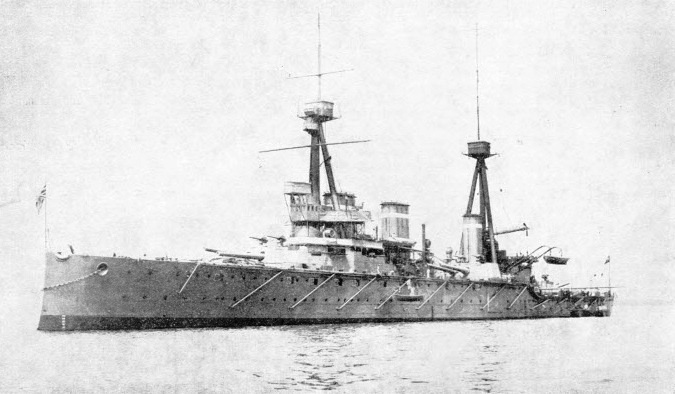
ADMIRAL STURDEE’S FLAGSHIP, the battle cruiser Invincible. After the defeat off Coronel the British Admiralty replied with amazing vigour and celerity. Two battle-
MORE than one characteristic has made the Falklands contest unique, for it was utterly different from the previous battles described in this work, and it was, in the opinion of many, the only decisive engagement between naval squadrons that was fought during the war of 1914-
We have almost full and complete knowledge of the Falklands action from the British and German sources. There are few gaps to be filled in. No small portion of this chapter has been derived direct from some who played most responsible parts at the fighting and have been able to dispel many possible errors on the subject.
The story begins towards the end of July 1914, For nearly two years H.M.S. Glasgow had been off the east coast of South America with Captain John Luce R.N., in command. She was a light cruiser of the “Town” class. Hers was a lonely and responsible duty, since no other British warship belonged to that station, but every three months her stores arrived from home, while her coal had to be obtained from British firms in South American ports.
This gallant officer, Captain Luce, who survived the Coronel battle and fought in the Falklands action, lived to be an Admiral, but died a few years ago. Before the outbreak of war he had arranged for a secret coaling base at the Abrolhos Rocks, where a coral reef lies some fifteen miles from the Brazilian coast between Rio and Bahia. Here anchorage could be found outside the three-
This base turned out to be most useful, and on August 4, 1914, when the telegram came to Captain Luce from the Admiralty announcing hostilities, the Glasgow slipped out of Rio and headed for the Abrolhos, warning all shipping on the way. Captain Luce had already arranged for one collier, but she had left Cardiff only three days before, could not be expected in less than a fortnight, and might be captured on the voyage by the enemy.
However, Captain Luce on August 5 luckily encountered a British tramp steamer with 10,000 tons of Welsh coal. Although she was bound for Rio, this ship was now commandeered and taken to Abrolhos. Thus, right at the outbreak of trouble, the single man-
Afterwards followed monotonous weeks of patrolling. The German steamship Santa Catherina was captured and brought to Abrolhos, and soon a change to greater activity became foreshadowed. Sounds of German wireless were heard and the cruiser Dresden on August 18 passed the Glasgow in the South Atlantic, well out to sea, though neither ship knew the other’s position. The Glasgow was now joined by the eleven-
In Whitehall, Their Lordships at the Admiralty were developing anxiety as to the movements of the German Admiral von Spee, whose squadron was steaming across the Pacific towards the western coast of South America. Rear-
By September 28 Cradock’s squadron of four had got farther south to Punta Arenas, in the Magellan Straits, where the future was discussed in detail. “Everything”, remarked Captain Luce, “pointed to a German concentration in the South Pacific, but von Spee could hardly reach the coast until the middle of October”. There existed for the British some difficulty with regard to wireless communication, because of “atmospherics”, but Admiral Cradock out of this confusion received the impression that the Admiralty wished him to push on up the west South American coast. Finally he sent H.M.S. Glasgow, Captain Luce, with the Monmouth and the Otranto thither, though these two vessels were quite weak units. The Monmouth, long overdue for a refit, was no faster than the German vessels, her fighting value inferior. The unarmoured hull of the Otranto, too, would be a perfect target for von Spee’s shells.
Mutilated Wireless Messages
In what Captain Luce described as “a hard gale with an enormous sea” the trio steamed round into the ill-
“It was clear,” Captain Luce said, “that Cradock was apprehensive of his position and asked for reinforcements. He realized the danger of von Spee passing us on the west coast and reaching the Atlantic to appear off the River Plate, where immense damage could be done unless there were a force to meet him in those regions. It always appears to me that we fell between two stools. There was not force available at the moment to form two squadrons of sufficient strength and speed, and we should not have advanced into the Pacific until this was forthcoming, but have concentrated in the vicinity of the Straits, using the Falklands as a base.”
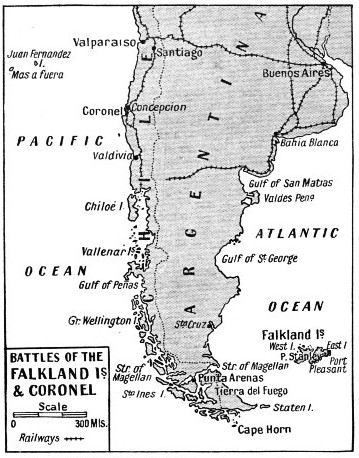
THE SOUTH AMERICAN COAST was the scene of sensational naval activities in the early months of the war of 1914-
Cradock’s keen fighting spirit would not allow him to act on the defensive, and the Admiralty seemed to urge him towards attack. Thus, in spite of having an inferior strength, his squadron was destined to enter upon an impossible struggle. The Glasgow was sent ahead from Vallenar to reconnoitre the Coronel area, and in steaming north she picked up German wireless signals coming from no great distance. “These were so strong,” said Captain Luce, “that we expected to sight the enemy at any moment”.
Early on October 30 Admiral Cradock left Vallenar with his three ships, and about 11 a.m. next day he wirelessed Captain Luce to enter Coronel, dispatch certain telegrams, obtain newspapers, mails and telegrams, and leave next day. The Glasgow went in at 6.30 p.m. and next day at 1 p.m. sighted the Good Hope and the Monmouth, with the Otranto. A strong wind and heavy sea were the conditions for the memorable Coronel battle that presently ensued. By means of a rum barrel the newspapers and copies of telegrams were transferred by the Glasgow to the flagship, and the squadron then proceeded further northward in line-
At 4.30 p.m. smoke was observed by the Glasgow to the north-
Finally the British squadron turned south in line ahead, the order being Good Hope, Monmouth, Glasgow and Otranto. By this time von Spee had increased his strength, for there had joined him two cruisers, the Leipzig and the Dresden.
Despite the British inferiority, Cradock, determined to attack, kept edging towards the enemy, but not till 7 p.m. did von Spee open fire. He had wisely waited until the sinking sun was no longer in his face, and now with a range of 12,000 yards began shelling targets that were silhouetted against the afterglow. It was certainly an historical moment since, more than a century after the battle of Trafalgar, here were British ships about to fight a premeditated action to the finish. But on this occasion there would be no protracted result and one single hour would suffice.
Before dark the Good Hope and the Monmouth were seen to be in a bad way. Before 8 p.m. these two had ceased to fight, and the liner Otranto had hauled out of line as unsuitable for action with Germany’s crack gunnery squadron. The German fire proved its remarkable accuracy, for the 8.2-
The loss of Admiral Cradock, with his two ships, was a heavy blow for the British nation; but the matter could not end there. The action of November 1 would have to be avenged.
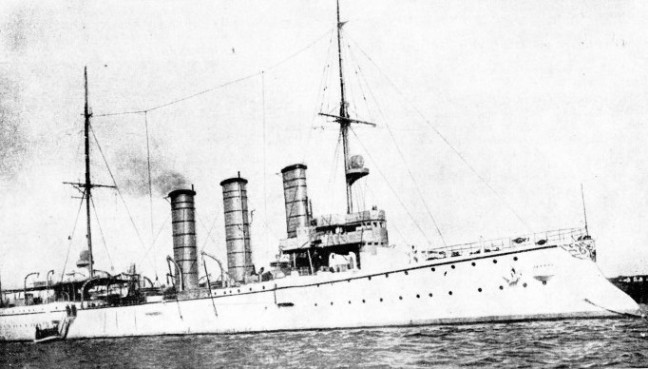
THE ONLY GERMAN SHIP TO ESCAPE DESTRUCTION at the battle of the Falklands on December 8 1914, was the Dresden. She succeeded in avoiding capture until March 1915, when she was blown up by her crew on discovery by the Glasgow, the Kent and the armed merchant cruiser Orama at the island of Juan Fernandez, in the Pacific Ocean. The Dresden was a cruiser of 3,592 tons, laid down in 1906. Turbines of 16,000 horse-
At noon on November 3 von Spee’s squadron reached Valparaiso, where South American Germans gave him an enthusiastic welcome, while the interned German steamers’ crews cheered him heartily as the victorious warships left again for Mas-
At the beginning of the war, Admiral F. C. Doveton Sturdee was Chief-
The British Admiralty reacted to the Coronel defeat with amazing vigour and celerity. On November 5, from the Grand Fleet were detached the two battle cruisers Invincible and Inflexible, which left Cromarty and went round the north and west of Scotland to Devonport, where they arrived three days later.
With secrecy and an enormous organizing effort, the two big ships were dry-
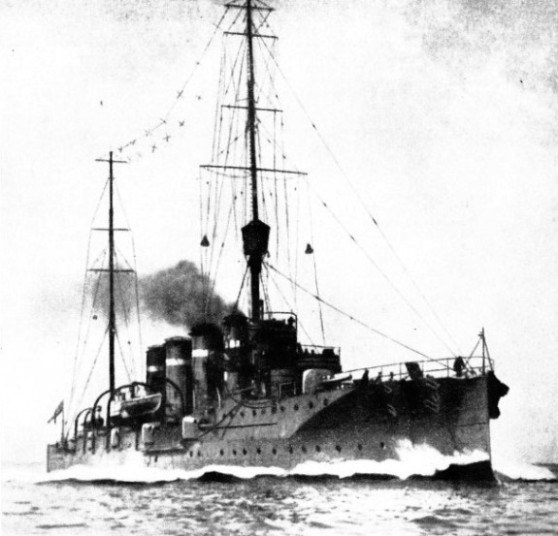
A SPEED OF 25 KNOTS was given by the 22,000-
They were given six months’ stores, and by the afternoon of November 11 were already steaming down the English Channel at 20 knots for the South Atlantic, Admiral Sturdee’s flag flying in the Invincible.
The secret of their mission had been wonderfully kept, yet it was still a race against time. Would they arrive before it was too late? Would not von Spee have done his worst long before these powerful modern units could reach South American waters?
Chance Delays von Spee
By avoiding trade routes, changing course to prevent strange shipping from reporting them, by not using wireless and calling for coal only at the lonely Cape Verde Islands, thence steaming across the ocean to the Abrolhos Rocks for further replenishment, Sturdee’s squadron was able to avoid any sort of publicity. Sturdee left the Abrolhos on November 28, where he had been joined by the repaired Glasgow and the four other cruisers, Carnarvon, Kent, Cornwall and Bristol, He set out for the Falklands just about the time von Spee was approaching the western end of the Magellan Straits. Lest the Germans should be making north, the British admiral spread out his ships ten miles apart, the Invincible being at the centre. On December 3 the armed merchant cruiser Macedonia also joined up.
Sturdee thus had under him two sister battle cruisers of 17,250 tons displacement, having 25 knots speed and armed with eight 12-
Von Spee’s five cruisers comprised the Scharnhorst and the Gneisenau, sister ships of 11,420 tons, 23 knots, armed with eight 8.2-
The British admiral who at such short notice had been sent on this long voyage was an expert in tactics, and on tactics — handling ships so as to use speed and guns to the best advantage —would victory rest. Yet it is curious how in these days of materialism and perfected mechanism mere chance created a most deciding influence. Had it not been for the sailing ship Drummuir, history would have been written differently.
This British barque was outward-
A Sensational Discovery
Sturdee’s three colliers were there waiting, and coaling began at once, so that the search for von Spee might be resumed on the evening of December 8. But, most dramatically, at 8 a.m. of that day the following signal from the shore was taken in by the Invincible:
“A four-
That message, if correct, could mean the approach of the Germans and none else. At the moment the Macedonia was anchored outside as lookout ship, but the Kent had steam up and was immediately dispatched to investigate. At 9.40 a.m. the Glasgow went out, and five minutes afterwards she was followed by the whole squadron, except the Bristol, which had drawn fires. Thus, within twenty-
The German Admiral had sent the Gneisenau and the Nurnberg ahead to reconnoitre, while his three other ships were still eight miles away. The first two closed to about five miles distant from the harbour, and a sub-
He reported that he saw two battle cruisers with tripod masts, and five other cruisers; but such sensational news could not be credited at first. Other officers focused their glasses, and then the painful surprise had to be accepted against further argument. There are few moments in naval history so full of drama as this. There have been few surprises at sea so bitter for any flag-
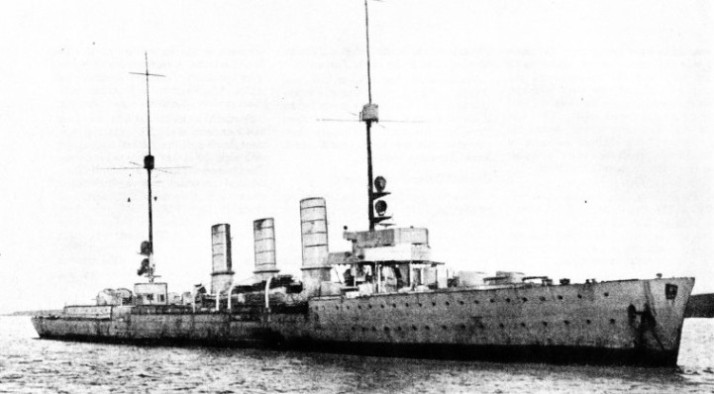
SINGLE-
The sharp contrast between an easy victory off Coronel and the unexpected apparition of superior British strength was enough to stun the imagination. The German Admiral had expected
not the slightest difficulty at the Falklands, where the 2,000 inhabitants could have put up no serious resistance and the German flag would have been hoisted before Sturdee’s arrival, but for the Drummuir episode. To have captured a British overseas possession would have been a fine pendant to the Coronel battle. It would have lowered British prestige in the eyes of other nations still further, and given a wonderful encouragement to the Germans in Europe.
That possibility, by the fortune of war and Lord Fisher’s foresight, had been swept right away instantaneously. When the two German cruisers with guns trained on the Falklands wireless station came within range of H.M.S. Canopus, she opened fire at 11,000 yards and the strangers turned away and hoisted their national colours. Von Spee sought to rectify his mistake, recalled these scouts, and the squadron went off at maximum speed to the eastward, afterwards altering to the south-
The Canopus, being an obsolete battleship of slow speed, could not join in the chase. Moreover she had been put on the mud in Port Stanley harbour, where her four 12-
Steam Raised in Ninety Minutes
In the hurried modification of naval routine, and the haste to get at the enemy, curious little mental pictures survived. The Inflexible, for example, rammed the Cornwall’s sailing pinnace which lay across the road to battle. The Glasgow was preceding the two battle cruisers, followed by the Cornwall and the Carnarvon, their new White Ensigns as stiff as boards, when the engines gradually worked up to high revolutions; but to have raised steam from cold boilers within ninety minutes
of the order had been a triumph for the engine-
At 10.20 a.m. Sturdee made the signal for a general chase, and now was manifested the supreme value of speed. Von Spee’s squadron nominally could do 23 knots, but each ship had been cruising for months without a scrub. The two British battle cruisers and the Glasgow were good for 25 knots at least, the former having been cleaned in dry-
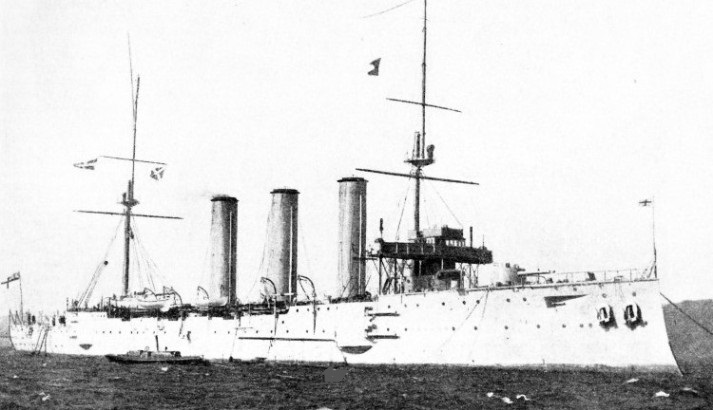
AN ARMOURED CRUISER OF 9,800 TONS DISPLACEMENT, H.M.S. Cornwall was responsible, with H.M.S. Glasgow, for the sinking of the German cruiser Leipzig at the battle of the Falklands on December 8, 1914. The Leipzig, the slowest of the three remaining German cruisers, was fired on by the Cornwall at 4.17 p.m. and three hours later burst into flames. At 9 p.m. she sank, leaving only the Dresden and the Nurnberg still flying the German flag. The Cornwall had a length of 440 feet, a beam of 66 feet and a mean draught of 24 ft. 6 in. Engines of 22,000 horse-
Meanwhile at 11.27 a.m. a wireless message had been received from the Bristol (which, in spite of being in the midst of mechanical repairs, had raised steam and put out to sea) that enemy units were off Port Pleasant. Admiral Sturdee ordered her and the armed merchant cruiser Macedonia to sink the latest strangers, who turned out to be von Spee’s two colliers. The German crews having been removed, the two steamers were destroyed. The British Admiral's difficulty was the shortness of daylight available, and the treacherous weather to be expected in those latitudes. Luckily the chase had begun during the forenoon, and at present it was almost an English spring day with a bright sun, light north-
At 12.20 p.m. Admiral Sturdee decided to attack with his three fast ships. Without awaiting the others, he would profit by the favourable meteorological conditions. At 12.55 the Inflexible opened fire with her fore turret at the Leipzig, which was the right-
The German Admiral’s intention thereby was to save his lighter units by scattering, but the British Commander-
Excellent German Gunnery
The battle therefore was now divided in two sections. The Scharnhorst with the Gneisenau in single-
A rapid fire was being exchanged, shells were bursting all round and on board the German ships, flash after flash travelling down their sides from bow to stern. There is no denying that the enemy’s gunnery was marvellous in its rapidity and control, and the amazing discovery came forth that von Spee’s 8.2-
At 1.45 the enemy hit the Invincible, but by altering course two points she threw the Germans off the range. Until 2.10, when the enemy turned to starboard, fire still went on rapidly. Then a thirty-
The Scharnhorst was so badly struck that she got on fire forward and the Inflexible severely punished the Gneisenau. By 3.15 the Scharnhorst had her third funnel shot away, and some of her guns ceased to fire.
The smoke greatly hindered the British battle cruisers almost continually, but the superiority of their speed enabled them always to choose their range, and now they were hurling destruction at the enemy. The condition of the Scharnhorst (von Spee’s flagship) could be judged from the escaping steam and fires which issued from her shell holes. Her second funnel had gone, yet from certain guns she pluckily maintained a steady accurate reply until about 4 p.m., when her decease was imminent.
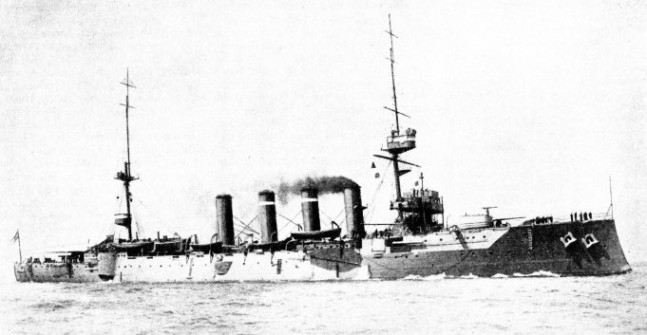
ONE OF SIX ARMOURED CRUISERS laid down in 1902 was the Carnarvon, of 10,850 tons displacement. H.M.S. Carnarvon assisted the Invincible and the Inflexible to sink the German cruiser Gneisenau at 6 p.m. on December 8, 1914, at the battle of the Falklands. The Carnarvon was armed with four 7.5-
With engines stopped, her hull blazing everywhere, she suddenly listed to port, rolled quietly over, halted a while on her beam ends, and at 1.17 p.m. dived headlong beneath the chill Atlantic waters. Her flag went down flying, von Spee suffering the same fate as Cradock, and the crew likewise; for not a soul was saved.
The Gneisenau could not last much longer, and the delay had now allowed the Carnarvon to come up, so that it was a matter of three ships to one. At 5.08 the Gneisenau’s forward funnel was knocked over, her fire slackened, yet she managed to hit the Invincible. At 5.30 the German ceased going ahead, steam and smoke and conflagrations pouring out from all quarters. She had fought to a standstill, expending all her ammunition including practice projectiles, and at 6 p.m. suddenly heeled over to dive below just as her sister ship, the Scharnhorst, had done.
The stronger enemy vessels were thus at the bottom, leaving three light cruisers still afloat and being chased by the Glasgow, the Kent and the Cornwall. It soon became apparent that the Dresden was the fastest and the Leipzig the slowest of the German trio. Shots were exchanged between hunters and hunted at 12,000 and even 11,000 yards, but the range would have to be closed before definite hits could be made. When the Leipzig steered more to starboard, she passed into the special attention of the Cornwall and the Glasgow, which were on that side. At 4.17 the Cornwall opened fire and three hours later the Leipzig burst into flames. At 9 p.m. she turned over, sank and was numbered with her two sisters that had gone before, thus leaving only the Dresden and the Nurnberg.
Since the Nurnberg had steered more to port, the Kent was assigned the duty of chasing her alone from 3.36 p.m., and a real ding-

Thus theoretically not more than half a knot was the difference in their speeds, though the Kent’s engines were five years older. One of the most exciting races now began — against time and the enemy — with the Nurnberg already five miles ahead. Admiral Allen gave the following description:
“Orders were sent to the engine-
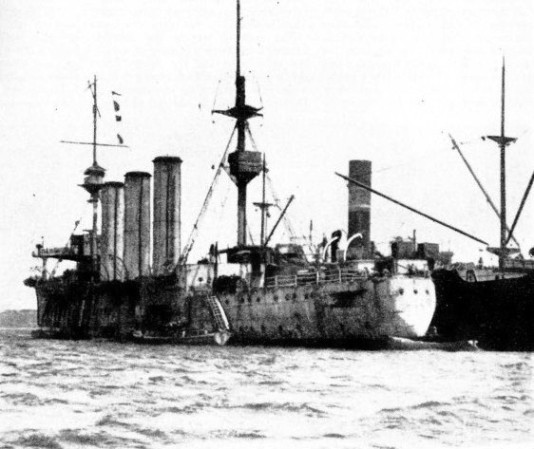
COALING AFTER THE BATTLE. Having defeated the Nurnberg after a fierce engagement, H.M.S. Kent reached the Falkland Islands with scarcely any coal in her bunkers, and damaged by the accurate fire from her opponent. Replenished with fuel, her next task —which lasted until March 1915 — was to seek out the escaped Dresden.
A remarkable feat it was, too, for an obsolescent cruiser, after eleven years, to get 2 more knots than her designed speed, though she began to exhaust her coal rapidly. About 5 p.m. she got within range, but again German guns were to prove their superiority, for the Nurnberg’s 4.1-
All this while the strain on boilers was enormous, and at 5.45 two of the Nurnberg’s burst, which brought her speed down to 19 knots. She turned to port, no longer able to escape, yet determined to fight the matter out with all her port guns. This suited the Kent. She also turned to port, opened fire with her starboard guns and came closer. At 6 p.m. the range was only 4,000 yards. Amid the wild noise of the explosion of shells, and the showers of splinters the critical stages were being decided.
How the enemy endured so much seemed hard to comprehend. Her fore topmast was gone, her funnels riddled, her speed reduced, and only two of her port guns were firing. At 6.10 she turned towards the Kent, who crossed the German’s bows and raked her with starboard guns which destroyed the German’s forecastle guns. Finally at 6.36 the Nurnberg, being 5,000 yards off, gave up the duel, stopped and burned gloriously. But she refrained from lowering her colours in surrender, so the Kent at 6.45 opened fire again, and five minutes afterwards the enemy hauled her ensign down. Just as it became dark the Nurnberg began to sink, whereupon the British cruiser got out boats to save life; but the second cutter and galley alone would float, and they first had to be patched to repair the damage caused by splinters. Lifebuoys, lifebelts, ropes-
Thirty-
In the Kent four men were killed and twelve wounded. Her wireless was shot away and she had been hit no fewer than thirty-
The task of tracing the Dresden became a matter not of days or weeks, but of months, and the Royal Navy rarely had a more elusive enemy to deal with. The Dresden on the evening of December 8 was the loneliest of homeless ships, with no admiral to obey and no sisters. Separated by thousands of miles from her own country, she became a marine nomad, a fugitive from battle. Her commanding officer, Captain Ludecke, after having brought his vessel from a most dangerous situation, took the Dresden into the Magellan Straits from the south, and had just time to coal at Punta Arenas before a British cruiser arrived.
For many weeks British cruisers were examining the many miles of tricky channels and fjords where the world’s worst gales blow and the mountains look down on desolate scenery.
It was an extraordinary thing that for more than two months a great game of hide-
During the first week of March, however, the Dresden, having passed into the Pacific, revealed her existence somewhere on the ocean by wirelessing her collier to meet her at a certain rendezvous. Thither H.M.S. Kent steamed in great haste, but with only 575 tons of coal left. At last, on March 8, at 3.50 p.m., the three-
Five days later, however, H.M.S. Glasgow, the Kent and the armed merchant cruiser Orama caught the fugitive Dresden. Her crew blew her up, and thus went the last of von Spee’s squadron.
The defeat at Coronel had been indeed avenged.
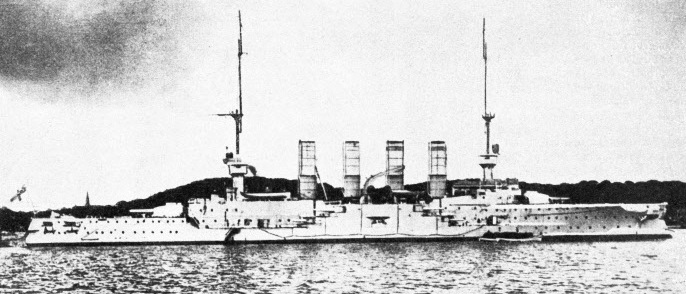
ADMIRAL VON SPEE’S FLAGSHIP at the battle of the Falklands was the armoured cruiser Scharnhorst, of 11,420 tons displacement. She was a sister ship to the Gneisenau. Both vessels were sunk on December 8, 1914. With two funnels shot away, engines stopped and her hull on fire from stem to stern, the Scharnhorst at 4.17 p.m. disappeared beneath the Atlantic with her flag still flying. Her armament included eight 8.2-
You can read more on “Battle of the Dardanelles”, “Modern Ocean Raiders” and “The Surrender of the German Fleet” on this website.